Alawites
|
Zulfiqar, a stylised representation of the sword of Ali, is an important symbol for Alawites | |
| Founder | |
|---|---|
| Ibn Nuṣayr | |
| Regions with significant populations | |
| 3 million[1] | |
| Ca. 700,000-750,000[2] | |
| Ca. 100,000-120,000[3][4][5] | |
| Lebanon/Golan Heights | 2,100 live in Ghajar |
| 2% of Lebanese-born people in Australia[6] | |
| Religions | |
| Shia Islam | |
| Scriptures | |
| Quran, List of Shia books | |
| Languages | |
| Arabic, Turkish | |
The Alawites, also known as Alawis (ʿAlawīyyah Arabic: علوية), are a religious group, centred in Syria, who follow a branch of the Twelver school of Shia Islam but with syncretistic elements. Alawites revere Ali (Ali ibn Abi Talib), and the name "Alawi" means followers of Ali. The sect is believed to have been founded by Ibn Nusayr during the 9th century. For this reason, Alawites are sometimes called "Nusayris" (Nuṣayrī Arabic: نصيرية), though this term has come to have derogatory connotations in the modern era; another name, "Ansari" (al-Anṣāriyyah), is believed to be a mistransliteration of "Nusayri". Today, Alawites represent 12 percent of the Syrian population and are a significant minority in Turkey and northern Lebanon. There is also a population living in the village of Ghajar in the occupied Golan Heights. They are often confused with the Alevis of Turkey, another Shia sect. Alawites form the dominant religious group on the Syrian coast and towns near the coast which are also inhabited by Sunnis, Christians, and Ismailis.
Alawites have historically kept their beliefs secret from outsiders and non-initiated Alawites, so rumours about them have arisen. Arabic accounts of their beliefs tend to be partisan (either positively or negatively).[7] However, since the early 2000s, Western scholarship on the Alawite religion has made significant advances.[8] At the core of Alawite belief is a divine triad, comprising three aspects of the one God. These aspects or emanations appear cyclically in human form throughout history. The last emanations of the divine triad, according to Alawite belief, were as Ali, Muhammad and Salman the Persian. Alawites were historically persecuted for these beliefs by the Sunni Muslim rulers of the area.
The establishment of the French Mandate of Syria marked a turning point in Alawi history. It gave the French the power to recruit Syrian civilians into their armed forces for an indefinite period and created exclusive areas for minorities, including an Alawite State. The Alawite State was later dismantled, but the Alawites continued to be a significant part of the Syrian army. Since Hafez al-Assad took power in 1970, the government has been dominated by a political elite led by the Alawite Al-Assad family. During the Islamic uprising in Syria in the 1970s and 1980s the establishment came under pressure, and the conflict continues as part of the Syrian civil war.
Etymology
The Alawites take their name from Ali ibn Abi Talib, cousin, son-in-law and first male follower of Muhammad[9] who is considered by Shia Muslims the first Shia Imam and the fourth Rashidun (Rightly-Guided Caliph) by Sunni Muslims.[10] French occupying forces used the term Alaouites, a transliteration into French.
In older sources, Alawis are often called Ansaris. According to Samuel Lyde, who lived among the Alawites during the mid-19th century, this was a term they used among themselves. Other sources indicate that "Ansari" is simply a Western error in the transliteration of "Nosairi".[11][12] However, the term "Nusayri" had fallen out of currency by the 1920s, as a movement led by intellectuals within the community during the French Mandate sought to replace it with the modern term "Alawi". They characterised the older name (which implied "a separate ethnic and religious identity") as an "invention of the sect's enemies", ostensibly favouring an emphasis on "connection with mainstream Islam"—particularly the Shia branch.[13] As such, "Nusayri" is now generally regarded as antiquated, and has even come to have insulting and abusive connotations. The term is frequently employed as hate speech by Sunni fundamentalists fighting against Bashar al-Assad's government in the Syrian civil war, who use its emphasis on Ibn Nusayr in order to insinuate that Alawi beliefs are "man-made" and not divinely inspired.[14] Recent research has shown that the Alawi appellation was used by the sect’s adherents since the 11th century. The following quote from Alkan (2012) illustrates this point: “In actual fact, the name ‘Alawī’ appears as early as in an 11 th-century Nuṣayrī tract (…). Moreover, the term ‘Alawī’ was already used at the beginning of the 20th century. In 1903 the Belgian-born Jesuit and Orientalist Henri Lammens (d. 1937) visited a certain Ḥaydarī-Nuṣayrī sheikh Abdullah in a village near Antakya and mentions that the latter preferred the name ‘Alawī’ for his people. Lastly, it is interesting to note that in the above-mentioned petitions of 1892 and 1909 the Nuṣayrīs called themselves the ‘Arab Alawī people’ (ʿArab ʿAlevī ṭāʾifesi) 'our ʿAlawī Nuṣayrī people’ (ṭāʾifatunā al-Nuṣayriyya al-ʿAlawiyya) or ‘signed with Alawī people’ (ʿAlevī ṭāʾifesi imżāsıyla). This early self-designation is, in my opinion, of triple importance. Firstly, it shows that the word ‘Alawī’ was always used by these people, as ʿAlawī authors emphasize; secondly, it hints at the reformation of the Nuṣayrīs, launched by some of their sheikhs in the 19tth century and their attempt to be accepted as part of Islam; and thirdly, it challenges the claims that the change of the identity and name from ‘Nuṣayrī’ to ʿAlawī’ took place around 1920, in the beginning of the French mandate in Syria (1919-1938).” [15]
The Alawites are distinct from the Alevi religious sect in Turkey, although the terms share a common etymology and pronunciation.[16][17]
History
Origins
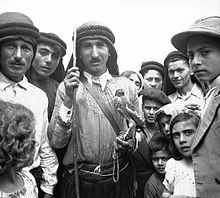
The origin of the Alawites is disputed. Local folklore suggests that they are descendants of the followers of the eleventh Imam, Hasan al-Askari (d. 873) and his pupil, Ibn Nusayr (d. 868).[18] During the 19th and 20th centuries, some Western scholars believed that Alawites were descended from ancient Middle Eastern peoples such as the Canaanites, Hittites,[19][20] or Mardaites.[21]
The Alawi religious sect seems to have been organised by a follower of Muhammad Ibn Nusayr known as Al-Khaṣībī, who died in Aleppo about 969 AD.[22] In 1032 Al-Khaṣībī's grandson and pupil, al-Tabarani, moved to Latakia (then controlled by the Byzantine Empire). Al-Tabarani influenced the Alawite faith through his writings and by converting the rural population of the Syrian Coastal Mountain Range.[22]
According to Bar Hebraeus, many Alawites were killed when the Crusaders initially entered Syria in 1097; however, they tolerated them when they concluded they were not a truly Islamic sect. Two prominent Alawite leaders in the following centuries, credited with uplifting the group, were Shaykhs al-Makhzun (d. 1220) and al-Tubani (d. 1300), both originally from Mount Sinjar in modern Iraq.[23]
In the 14th century, the Alawites were forced by Mamluk ruler Baibars to build mosques in their settlements, to which they responded with token gestures described by the Muslim traveler Ibn Battuta.[24][25] During the reign of Selim I, of the Ottoman Empire, the Alawites would again experience significant persecution.[26]
Ottoman Empire
The Ottoman Empire oppressed the Alawites,[27] attempting to convert them to Sunni Islam.[28] The Alawis rose up against the Ottomans on several occasions, and maintained their autonomy in their mountains.[29]
In his book, Seven Pillars of Wisdom, T. E. Lawrence wrote:
The sect, vital in itself, was clannish in feeling and politics. One Nosairi would not betray another, and would hardly not betray an unbeliever. Their villages lay in patches down the main hills to the Tripoli gap. They spoke Arabic, but had lived there since the beginning of Greek letters in Syria. Usually they stood aside from affairs, and left the Turkish Government alone in hope of reciprocity.[30]
During the 18th century, the Ottomans employed a number of Alawite leaders as tax collectors under the iltizam system. Between 1809 and 1813, Mustafa Agha Barbar, the governor of Tripoli, attacked the Kalbiyya Alawites with "marked savagery."[31] Some Alawites supported Ottoman involvement in the Egyptian-Ottoman Wars of 1831–1833 and 1839–1841,[32] and had careers in the Ottoman army or as Ottoman governors.[33]
By the mid-19th century, the Alawite people, customs and way of life were described by Samuel Lyde, an English missionary among them, as suffering from nothing except a gloomy plight.[34]
Early in the 20th century the mainly-Sunni Ottoman leaders were bankrupt and losing the political power, and the Alawites were poor peasants.[35][36] Alawites were not allowed to testify in court until after World War I and the dissolution of the Ottoman Empire.[37]
French Mandate period
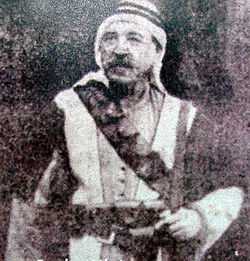
After the end of World War I and the fall of the Ottoman Empire, Syria and Lebanon were placed by the League of Nations under the French Mandate for Syria and the Lebanon. On 15 December 1918 Alawite leader Saleh al-Ali called for a meeting of Alawite leaders in the town of Sheikh Badr, urging them to revolt and expel the French from Syria.
When French authorities heard about the meeting, they sent a force to arrest Saleh al-Ali. He and his men ambushed and defeated the French forces at Sheikh Badr, inflicting more than 35 casualties.[38] After this victory al-Ali began organising his Alawite rebels into a disciplined force, with its own general command and military ranks.
The Sheikh Badr skirmish began the Syrian Revolt of 1919.[38][39] Al-Ali responded to French attacks by laying siege to (and occupying) al-Qadmus, from which the French had conducted their military operations against him.[38] In November, General Henri Gouraud mounted a campaign against Saleh al-Ali's forces in the An-Nusayriyah Mountains. His forces entered al-Ali's village of al-Shaykh Badr, arresting many Alawi leaders; however, Al-Ali fled to the north. When a large French force overran his positions, he went underground.[38]
However, despite these instances of opposition, the Alawites greatly favoured French rule and sought its continuation beyond the mandate period.[40]
Alawite State

When the French began to occupy Syria in 1920,[41] an Alawite State was created in the coastal and mountain country comprising most Alawite villages; the French justified this by citing differences between the "backwards" mountain people and the mainstream Sunnis. The division also intended to protect the Alawite people from more-powerful majorities, such as the Sunnis.
The French also created microstates, such as Greater Lebanon for the Maronite Christians and Jabal al-Druze for the Druze. Aleppo and Damascus were also separate states.[42] Under the Mandate many Alawite chieftains supported a separate Alawite nation, and tried to convert their autonomy into independence.
The French encouraged Alawites to join their military forces, in part to provide a counterweight to the Sunni majority (which was more hostile to their rule). According to a 1935 letter by the French minister of war, the French considered the Alawites and the Druze the only "warlike races" in the Mandate territories.[43]
The region was home to a mostly-rural, heterogeneous population. The landowning families and 80 percent of the population of the port city of Latakia were Sunni Muslim; however, in rural areas 62 percent of the population were Alawite peasants. There was considerable Alawite separatist sentiment in the region,[44] evidenced by a 1936 letter signed by 80 Alawi leaders addressed to the French Prime Minister which said that the "Alawite people rejected attachment to Syria and wished to stay under French protection". Among the signatories was Sulayman Ali al-Assad, father of Hafez al-Assad.[44] Even during this time of increased Alawite rights, the situation was still so bad for the group that many females had to leave their homes to work for urban Sunnis - many becoming mistresses to their employers - which is why it was estimated that 25% of all Alawite children in the 1930s and 40s had Sunni fathers.[45]
In May 1930, the Alawite State was renamed the Government of Latakia in one of the few concessions by the French to Arab nationalists before 1936.[44][44] Nevertheless, on 3 December 1936 the Alawite State was re-incorporated into Syria as a concession by the French to the Nationalist Bloc (the party in power in the semi-autonomous Syrian government). The law went into effect in 1937.[46]
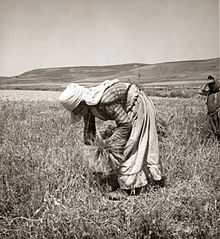
In 1939, the Sanjak of Alexandretta (now Hatay) contained a large number of Alawites. The Hatayan land was given to Turkey by the French after a League of Nations plebiscite in the province. This development greatly angered most Syrians; to add to Alawi contempt, in 1938 the Turkish military went into İskenderun and expelled most of the Arab and Armenian population.[47] Before this, the Alawite Arabs and Armenians comprised most of the province's population.[47] Zaki al-Arsuzi, a young Alawite leader from Iskandarun province in the Sanjak of Alexandretta who led the resistance to the province's annexation by the Turks, later became a co-founder of the Ba'ath Party with Eastern Orthodox Christian schoolteacher Michel Aflaq and Sunni politician Salah ad-Din al-Bitar.
After World War II, Sulayman al-Murshid played a major role in uniting the Alawite province with Syria. He was executed by the Syrian government in Damascus on 12 December 1946, only three days after a political trial.
After Syrian independence
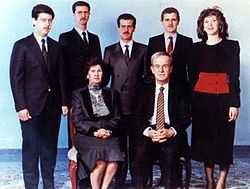
Syria became independent on 17 April 1946. In 1949, after the 1948 Arab–Israeli War, Syria experienced a number of military coups and the rise of the Ba'ath Party.
In 1958, Syria and Egypt were united by a political agreement into the United Arab Republic. The UAR lasted for three years, breaking apart in 1961 when a group of army officers seized power and declared Syria independent.
A succession of coups ensued until, in 1963, a secretive military committee (including Alawite officers Hafez al-Assad and Salah Jadid) helped the Ba'ath Party seize power. In 1966 Alawite-affiliated military officers successfully rebelled and expelled the Ba’ath Party old guard followers of Greek Orthodox Christian Michel Aflaq and Sunni Muslim Salah ad-Din al-Bitar, calling Zaki al-Arsuzi the "Socrates" of the reconstituted Ba'ath Party.
In 1970 Air Force General Hafez al-Assad, an Alawite, took power and instigated a "Correctionist Movement" in the Ba'ath Party. The coup of 1970 ended the political instability which had existed since independence.[48] Robert D. Kaplan compared Hafez al-Assad's coming to power to "an untouchable becoming maharajah in India or a Jew becoming tsar in Russia—an unprecedented development shocking to the Sunni majority population which had monopolized power for so many centuries".[41] In 1971 al-Assad declared himself president of Syria, a position the constitution at the time permitted only for Sunni Muslims. In 1973 a new constitution was adopted, replacing Islam as the state religion with a mandate that the president's religion be Islam, and protests erupted.[49] In 1974, to satisfy this constitutional requirement, Musa as-Sadr (a leader of the Twelvers of Lebanon and founder of the Amal Movement, who had unsuccessfully sought to unite Lebanese Alawites and Shiites under the Supreme Islamic Shiite Council)[50] issued a fatwa that Alawites were a community of Twelver Shiite Muslims.[51] Under the authoritarian, secular Assad government, religious minorities were tolerated more than before but political dissidents were not. In 1982, when the Muslim Brotherhood mounted an anti-government Islamist insurgency, Hafez Assad staged a military offensive against them known as the Hama massacre.
Beliefs
| |||
|---|---|---|---|
| The Fourteen Infallibles | |||
|
|||
| Principles | |||
| Other beliefs | |||
| Practices | |||
| Holy cities | |||
| Groups | |||
|
|
|||
| Scholarship | |||
| Hadith collections | |||
| Related topics | |||
|
|||
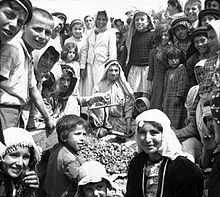
Theology and practices
Alawites consider themselves to be Muslims, although some Sunnis dispute that they are.[52] Alawite doctrine incorporates Gnostic, neo-Platonic, Islamic, Christian and other elements and has, therefore, been described as syncretistic.[53][54]
Alawite beliefs have never been confirmed by their modern religious authorities.[55] Alawites tend to conceal their beliefs (taqiyya) due to historical persecution.[56] Some tenets of the faith are secret, known only to a select few;[27][57] therefore, they have been described as a mystical sect.[58]
Divinity
Their theology is based on a divine triad,[52][59][60] or trinity, which is the core of Alawite belief.[61] The triad comprises three emanations of the one God: the supreme aspect or entity called the "Essence"[61] or the "Meaning"[60] (both being translations of ma'na), together with two lesser emanations known as his "Name" (ism), or "Veil" (hijab), and his "Gate" (bab).[59][60][61][62] These emanations have manifested themselves in different human forms over several cycles in history, the last cycle of which was as Ali (the Essence/Meaning), Muhammad (the Name) and Salman the Persian (the Gate).[59][61][62][63] Alawite belief is summarised in the formula: "I turn to the Gate; I bow before the Name; I adore the Meaning".[52][64]
Reincarnation
Alawites hold that they were originally stars or divine lights that were cast out of heaven through disobedience and must undergo repeated reincarnation (or metempsychosis[61]) before returning to heaven.[52][62] They can be reincarnated as Christians or others through sin and as animals if they become infidels.[52][65]
Other beliefs
Other beliefs and practices include: the consecration of wine in a secret form of Mass only open to males; frequently being given Christian names; burying the dead in sarcophagi above ground; observing Nowruz, Epiphany, Christmas[66] and the feast days of John Chrysostom and Mary Magdalene;[67] the only religious structures they have are the shrines of tombs;[68] the alleged book Kitab al Majmu, which is supposedly a central source of Alawite doctrine.
Some scholars claim that alawites do not believe women have souls or that they simply do not reincarnate.[69][70][71][72]
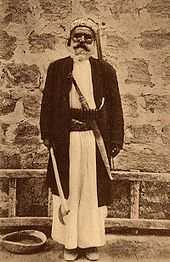
Opinions on position within Islam
Alawites have always described themselves as being Twelver Shiite Muslims and have been recognized as such by the prominent Lebanese Shiite cleric Musa al-Sadr[73] and Iranian religious and political leader Ruhollah Khomeini.[74][75] The Sunni Grand Mufti of Jerusalem Haj Amin al-Husseini issued a fatwa recognising them as part of the Muslim community in the interest of Arab nationalism.[76][77] However, Athari Sunni (modern day Salafis) scholars such as Ibn Kathir have categorised Alawites as pagans in their writings;[27][78][79] with Ibn Taymiyya arguably being the most virulent anti-Alawite in his fatwas[80] and accusing them of aiding the Crusader and Mongol enemies of the Muslims.[81] Other Sunni scholars, such as Al-Ghazali, also approved of violence against Alawites, whom he considered as non-Muslims.[82] Interestingly, Benjamin Disraeli, in his novel Tancred, also expressed the view that Alawites are not Muslims.[83]
Barry Rubin has suggested that Syrian leader Hafez al-Assad and his son and successor Bashar al-Assad pressed their fellow Alawites "to behave like 'regular Muslims', shedding (or at least concealing) their distinctive aspects".[84] During the early 1970s a booklet, al-`Alawiyyun Shi'atu Ahl al-Bait ("The Alawites are Followers of the Household of the Prophet") was published, which was "signed by numerous 'Alawi' men of religion", described the doctrines of the Imami Shia as Alawite.[85] Additionally, there has been a recent movement to unite Alawism and the other branches of Twelver Islam through educational exchange programs in Syria and Qom.[86]
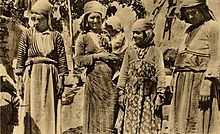
Some sources have discussed the "Sunnification" of Alawites under the al-Assad regime.[87] Joshua Landis, director of the Center for Middle East Studies, writes that Hafiz al-Assad "tried to turn Alawites into 'good' (read Sunnified) Muslims in exchange for preserving a modicum of secularism and tolerance in society". On the other hand, Al-Assad "declared the Alawites to be nothing but Twelver Shiites".[87] In a paper, "Islamic Education in Syria", Landis wrote that "no mention" is made in Syrian textbooks (controlled by the Al-Assad regime) of Alawites, Druze, Ismailis or Shia Islam; Islam was presented as a monolithic religion.[88]
Ali Sulayman al-Ahmad, chief judge of the Baathist Syrian state, has said:
We are Alawi Muslims. Our book is the Qur'an. Our prophet is Muhammad. The Ka`ba is our qibla, and our Dīn (religion) is Islam.[55]
Population

Syria
Alawites have traditionally lived in the An-Nusayriyah Mountains along the Mediterranean coast of Syria. Latakia and Tartus are the region's principal cities. They are also concentrated in the plains around Hama and Homs. Alawites also live in Syria's major cities, and are estimated at about 12 percent of the country's population[89][90][91] (2.6 million, out of a total population of 22 million).[92]
There are four Alawite confederations — Kalbiyya, Khaiyatin, Haddadin, and Matawirah — each divided into tribes.[27] Alawites are concentrated in the Latakia region of Syria, extending north to Antioch (Antakya), Turkey, and in and around Homs and Hama.[93]
Before 1953 Alawites held specifically-reserved seats in the Syrian Parliament, in common with all other religious communities. After that (including the 1960 census) there were only general Muslim and Christian categories, without mention of subgroups, to reduce sectarianism (taïfiyya).
Turkey
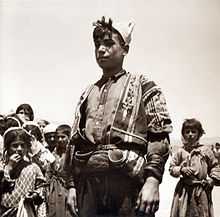
To avoid confusion with the Alevis, the Alawites call themselves Arap Alevileri ("Arab Alevis") in Turkish. The term Nusayrī, previously used in theological texts, has been revived in recent studies. In Çukurova, Alawites are known as Fellah and Arabuşağı (although the latter is considered offensive) by the Sunni population. A quasi-official name used during the 1930s by Turkish authorities was Eti Türkleri ("Hittite Turks"), to conceal their Arabic origins. Although this term is obsolete, it is still used by some older people as a euphemism.
The exact number of Alawites in Turkey is unknown; there were 185,000 in 1970,[94] suggesting about 400,000 in 2009. As Muslims, they are not recorded separately from Sunnis. In the 1965 census (the last Turkish census where informants were asked their mother tongue), 180,000 people in the three provinces declared their mother tongue as Arabic; however, Arabic-speaking Sunnis and Christians were also included in this figure. Turkish Alawites traditionally speak the same dialect of Levantine Arabic as Syrian Alawites. Arabic is preserved in rural communities and in Samandağ. Younger people in the cities of Çukurova and İskenderun tend to speak Turkish. The Turkish spoken by Alawites is distinguished by its accents and vocabulary. Knowledge of the Arabic alphabet is confined to religious leaders and men who have worked or studied in Arab countries.
Alawites demonstrate considerable social mobility. Until the 1960s, they were bound to Sunni aghas (landholders) around Antakya and were poor. Alawites are prominent in the sectors of transportation and commerce and a large, professional middle class has emerged. Male exogamy has increased, particularly by those who attend universities or live in other parts of Turkey. These marriages are tolerated; however, female exogamy (as in other patrilineal groups) is discouraged.
Alawites, like Alevis, have strong leftist political beliefs. However, some people in rural areas (usually members of notable Alawite families) may support secular, conservative parties such as the Democratic Party. Most Alawites feel oppressed by the policies of the Presidency of Religious Affairs in Turkey (Diyanet İşleri Başkanlığı).[95][96]
Lebanon
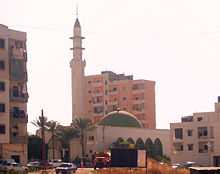
There are an estimated 100,000 to 120,000[3][97] Alawites in Lebanon, where they have lived since at least the 16th century.[98] They are one of the 18 official Lebanese sects; due to the efforts of their leader, Ali Eid, the Taif Agreement of 1989 gave them two reserved seats in Parliament. Lebanese Alawites live primarily in the Jabal Mohsen neighbourhood of Tripoli (where they number 40,000–60,000) and in 15 villages in the Akkar District, and are represented by the Arab Democratic Party.[99][100][101] Their Mufti is Sheikh Assad Assi.[102] The Bab al-Tabbaneh–Jabal Mohsen conflict between pro-Syrian Alawites and anti-Syrian Sunnis has affected Tripoli for decades.[103]
There are also about 2,000 Alawites living in the village of Ghajar, which is split between Lebanon and the Golan Heights.[104] In 1932 the residents of Ghajar were given the option of choosing their nationality, and overwhelmingly chose to be a part of Syria (which has a sizable Alawite minority).[105] Before the 1967 Arab-Israeli War, the residents of Ghajar were counted in the 1960 Syrian census.[106] When Israel captured the Golan Heights from Syria in 1967, Ghajar was a no man's land for two-and-a-half months.
See also
References
- ↑ "The 'secretive sect' in charge of Syria". BBC. 17 May 2012. Retrieved 14 January 2015.
- ↑ "On Turkey's Syrian frontier, fears of a sectarian spillover". Reuters. Retrieved 28 August 2013.
- ↑ 3.0 3.1 http://www.repost.us/article-preview/#!hash=0467cbf01990a23ab00bfe1a45696310
- ↑ "Lebanese Allawites welcome Syria's withdrawal as 'necessary'". The Daily Star. 30 April 2005.
The Alawis have been present in modern-day Lebanon since the 16th century and are estimated to number 100,000 today, mostly in Akkar and Tripoli. The sect is managed through the Islamic Alawi Union, a council of 600 members that are elected every four years.
- ↑ "Lebanon’s Alawi: A Minority Struggles in a ‘Nation’ of Sects". Al Akhbar English. 8 November 2011. Retrieved 6 July 2012.
- ↑ Ghassan Hage (2002). Arab-Australians today: citizenship and belonging (Paperback ed.). Melbourne University Publishing. p. 40. ISBN 0-522-84979-2.
- ↑ Friedman, Yaron (2010). The Nuṣayrī-ʻAlawīs: An Introduction to the Religion, History, and Identity of the Leading Minority in Syria. p. 68. ISBN 9004178929.
- ↑ Friedman, Yaron (2010). The Nuṣayrī-ʻAlawīs: An Introduction to the Religion, History, and Identity of the Leading Minority in Syria. p. 67. ISBN 9004178929.
- ↑ Kaplan, Robert (February 1993). "Syria: Identity Crisis". The Atlantic.
The term "Alawi" means "follower of Ali", the son-in-law of prophet Mohammed who is venerated by millions of Shi'ites in Iran and elsewhere.
- ↑ Minahan, James (2002). Encyclopedia of the Stateless Nations: A-C. Greenwood Publishing. ISBN 9780313321092. Retrieved 6 July 2012.
- ↑ Clymer, R. Swinburne (1 April 2003). Initiates and The People Part 2, May 1929 to June 1930. Kessinger Publishing. ISBN 9780766153769. Retrieved 6 July 2012.
- ↑ Howse, Christopher (5 August 2011). "Secretive sect of the rulers of Syria". The Daily Telegraph.
- ↑ al-Tamimi, Aymenn Jawad (24 January 2013). "Anti-Islamism in an Islamic Civil War". The American Spectator. Retrieved 4 November 2013.
- ↑ Landis, Joshua (15 December 2013). "Zahran Alloush: His Ideology and Beliefs". Syria Comment. Retrieved 24 December 2013.
- ↑ See, Alkan, N. (2012) and the references cited therein. Alkan, N. Fighting for the Nuṣayrī Soul: State, Protestant Missionaries and the ʿAlawīs in the Late Ottoman Empire, Die Welt des Islams, 52 (2012) pp. 23-50.
- ↑ "Erdogan, Iran, Syrian Alawites, and Turkish Alevis". The Weekly Standard. 29 March 2012. Retrieved 6 July 2012.
- ↑ The Plain of Saints and Prophets: The Nusayri-Alawi Community of Cilicia ... - Gisela Procházka-Eisl, Stephan Procházka. Harrassowitz Verlag. 11 August 2010. ISBN 9783447061780. Retrieved 6 July 2012.
- ↑ "Alawi Islam in the 11th Encyclopædia Britannica". 1911.
Among the more plausible explanations is that the name is derived from that of Abu Shu'ayb Muhammad ibn Nusayr, who was an Isma'ilite follower of the eleventh imam of the Shiites at the end of the 9th century. This view has been accepted by Nosairi writers, but they transfer Ibn Nusayr to the 7th century and make him the son of the vizier of Moawiyah.
- ↑ Lyde, Samuel (1860). The Asian mystery illustrated in the history, religion, and present state of ... Longman, Green, Longman and Roberts. Retrieved 6 July 2012.
- ↑ Journal of the Royal Anthropological Institute (London, 1911), p.241.
- ↑ Mordechai Nisan (1 Jan 2002). Minorities in the Middle East: A History of Struggle and Self-Expression, 2d ed. McFarland. pp. 114–15. ISBN 9780786451333.
- ↑ 22.0 22.1 Halm, Heinz (2004). Shi'ism. Edinburgh University Press. p. 157. ISBN 9780748618880. Retrieved 17 January 2010.
- ↑ Matti Moosa (1987). Extremist Shiites: The Ghulat Sects. Syracuse University Press. pp. 269–71. ISBN 9780815624110.
- ↑ Daniel Pipes (1992). Greater Syria. Oxford University Press. p. 161. ISBN 9780195363043.
"Every village built a mosque far from the houses, which the villagers neither enter nor maintain. They often shelter cattle and asses in it. Often a stranger arrives and goes to the mosque to recite the [Islamic] call to prayer; then they yell to him, 'Stop braying, your fodder is coming.' " [Ibn Battuta]
- ↑ Matti Moosa (1987). Extremist Shiites: The Ghulat Sects. Syracuse University Press. pp. 270–1. ISBN 9780815624110.
- ↑ Matti Moosa (1987). Extremist Shiites: The Ghulat Sects. Syracuse University Press. p. 275. ISBN 9780815624110.
- ↑ 27.0 27.1 27.2 27.3 "Alawi Islam". Globalsecurity.org.
- ↑ Seale, Patrick. Asad of Syria: The Struggle for the Middle East. With the assistance of Maureen McConville. Berkeley: University of California Press, 1989, c1988.
- ↑ Mordechai Nisan. Minorities in the Middle East: a history of struggle and self-expression. McFarland, 2002. ISBN 0-7864-1375-1, ISBN 978-0-7864-1375-1
- ↑ T. E. Lawrence. Seven Pillars of Wisdom. Book 5, Chapter 58.
- ↑ Matti Moosa (1987). Extremist Shiites: The Ghulat Sects. Syracuse University Press. p. 276. ISBN 9780815624110.
- ↑ Winter, Stefan (1999). "La révolte alaouite de 1834 contre l'occupation égyptienne: perceptions alaouites et lecture ottomane". Oriente Moderno (in French) 79 (3): 60–71.
- ↑ Winter, Stefan (2004). "The Nusayris before the Tanzimat in the Eyes of Ottoman Provincial Administrators, 1804-1834". In Philipp, Thomas; Schumann, Christoph. From the Syrian Land to the States of Syria and Lebanon. Würzburg: Ergon. pp. 97–112. ISBN 3899133536.
- ↑ Matti Moosa (1987). Extremist Shiites: The Ghulat Sects. Syracuse University Press. p. 277. ISBN 9780815624110.
- ↑ Field, Michael (1 March 1996). Inside the Arab World -. Harvard University Press. ISBN 9780674455214. Retrieved 6 July 2012.
- ↑ Stratfor (5 May 2011). "Making Sense of the Syrian Crisis". Stratfor. Retrieved 6 July 2012.
- ↑ Kirkpatrick, David D. (3 September 2012). "Syrian Children Offer Glimpse of a Future of Reprisals". The New York Times.
- ↑ 38.0 38.1 38.2 38.3 Moosa, Matti (1987). Extremist Shiites: The Ghulat Sects. Syracuse University Press. pp. 282–283. ISBN 0-8156-2411-5.
- ↑ Moubayed, Sami M. (2006). Steel & Silk: Men & Women Who Shaped Syria 1900-2000. Cune Press. pp. 363–364. ISBN 1-885942-41-9.
- ↑ Daniel Pipes (1992). Greater Syria. Oxford University Press. pp. 166–8. ISBN 9780195363043.
- ↑ 41.0 41.1 Kaplan, Robert (February 1993). "Syria: Identity Crisis". The Atlantic.
- ↑ Longrigg, Stephen Hemsley. Syria and Lebanon Under French Mandate. London: Oxford University Press, 1958.
- ↑ William W. Harris (2003). The Levant: a fractured mosaic. Markus Wiener Publishers. ISBN 9781558762640. Retrieved 6 July 2012.
- ↑ 44.0 44.1 44.2 44.3 Khoury, Philip S. Syria and the French Mandate: The Politics of Arab Nationalism, 1920–1945. Princeton: Princeton University Press, 1987.
- ↑ Daniel Pipes (1992). Greater Syria. Oxford University Press. p. 165. ISBN 9780195363043.
- ↑ Shambrook, Peter A. French Imperialism in Syria, 1927–1936. Reading: Ithaca Press, 1998.
- ↑ 47.0 47.1 Jack Kalpakian (2004). Identity, Conflict and Cooperation in International River Systems (Hardcover ed.). Ashgate Publishing. p. 130. ISBN 0-7546-3338-1.
- ↑ Kaplan, Robert (February 1993). "Syria: Identity Crisis". The Atlantic.
But the coup of 1970, which brought an Alawi air force officer, Hafez al-Assad, to power, was what finally ended the instability that had reigned in Syria since the advent of independence.
- ↑ Seale, Patrick. Asad, the Struggle for the Middle East. University of California Press, 1989, p.173.
- ↑ Riad Yazbeck. "Return of the Pink Panthers?" Mideast Monitor. Vol. 3, No. 2, August 2008.
- ↑ The New Encyclopedia of Islam by Cyril Glasse, Altamira, 2001, p.36–7
- ↑ 52.0 52.1 52.2 52.3 52.4 "Alawi Islam". Globalsecurity.org
- ↑ Prochazka-Eisl, Gisela; Prochazka, Stephan (2010). The Plain of Saints and Prophets: The Nusayri-Alawi Community of Cilicia. p. 81. ISBN 3447061782.
- ↑ Friedman, Yaron (2010). The Nuṣayrī-ʻAlawīs: An Introduction to the Religion, History, and Identity of the Leading Minority in Syria. p. 67. ISBN 9004178929.
- ↑ 55.0 55.1 'Abd al‑Latif al‑Yunis, Mudhakkirat al‑Duktur 'Abd al‑Latif al‑Yunis, Damascus: Dar al‑`Ilm, 1992, p. 63.
- ↑ Secretive sect of the rulers of Syria, The Telegraph, 05 Aug 2011
- ↑ The Nuaayri-Alawis (2009) Yaron Friedman
- ↑ Lebanon: current issues and background, John C. Rolland (2003). Nova. 1 August 2003. ISBN 9781590338711. Retrieved 25 December 2012.
- ↑ 59.0 59.1 59.2 Böwering, Gerhard et al. (eds.) (2012). The Princeton Encyclopedia of Islamic Political Thought. p. 29. ISBN 0691134847.
- ↑ 60.0 60.1 60.2 Friedman, Yaron (2010). The Nuṣayrī-ʻAlawīs: An Introduction to the Religion, History, and Identity of the Leading Minority in Syria. p. 77. ISBN 9004178929.
- ↑ 61.0 61.1 61.2 61.3 61.4 Prochazka-Eisl, Gisela; Prochazka, Stephan (2010). The Plain of Saints and Prophets: The Nusayri-Alawi Community of Cilicia. p. 82. ISBN 3447061782.
- ↑ 62.0 62.1 62.2 Peters, F.E. (2009). The Monotheists: Jews, Christians, and Muslims in Conflict and Competition, Volume II. p. 321. ISBN 1400825717.
- ↑ Friedman, Yaron (2010). The Nuṣayrī-ʻAlawīs: An Introduction to the Religion, History, and Identity of the Leading Minority in Syria. pp. 80, 93–94. ISBN 9004178929.
- ↑ "The 'secretive sect' in charge of Syria". BBC. 17 May 2012. Retrieved 25 December 2012.
- ↑ Alawis, Countrystudies.us, U.S. Library of Congress.
- ↑ David S. Sorenson (3 Dec 2013). An Introduction to the Modern Middle East: History, Religion, Political Economy, Politics. Westview Press. p. 64. ISBN 9780813349220.
- ↑ Robert Brenton Betts (31 Jul 2013). The Sunni-Shi'a Divide: Islam's Internal Divisions and Their Global Consequences (illustrated ed.). Potomac Books, Inc. p. 29. ISBN 9781612345222.
- ↑ Daniel Pipes (1992). Greater Syria. Oxford University Press. p. 161. ISBN 9780195363043.
- ↑ Mordechai Nisan (1 Jan 2002). Minorities in the Middle East: A History of Struggle and Self-Expression, 2d ed. McFarland. p. 116. ISBN 9780786451333.
- ↑ Charles George Herbermann (2005). Encyclopaedia of sects & religious doctrines, Volume 1 (3rd ed.). Cosmo Publications. pp. 15–16. ISBN 9788177559286.
- ↑ Nanny M. W. de Vries; Jan Best. Thamyris. Rodopi. p. 290.
- ↑ Ian Strathcarron (2012). Innocence and War: Mark Twain's Holy Land Revisited (illustrated, reprint ed.). Courier Corporation. p. 78. ISBN 9780486490403.
- ↑ Kramer, Martin. "Syria's '‘Alawis and Shi‘ism".
In their mountainous corner of Syria, the 'Alawī claim to represent the furthest extension of Twelver Shiism.
- ↑ Diana Darke (2010). Syria (illustrated ed.). Bradt Travel Guides. p. 217. ISBN 9781841623146.
- ↑ Seyyed Vali Reza Nasr (17 Apr 2007). The Shia Revival: How Conflicts Within Islam Will Shape the Future (illustrated, reprint, annotated ed.). W. W. Norton & Company. p. 92. ISBN 9780393329681.
- ↑ Talhamy, Y. (2010). "The Fatwas and the Nusayri/Alawis of Syria". Middle Eastern Studies 46 (2): 175–194. doi:10.1080/00263200902940251.
- ↑ Me'ir Mikha'el Bar-Asher; Gauke de Kootstra; Arieh Kofsky (2002). The Nuṣayr−i-ʻalaw−i Religion: An Enquiry Into Its Theology and Liturgy. BRILL. p. 1. ISBN 978-90-04-12552-0. Retrieved 18 March 2011.
- ↑ Syria crisis: Deadly shooting at Damascus funeral
- ↑ Abd-Allah, Umar F., Islamic Struggle in Syria, Berkeley : Mizan Press, c1983, pp. 43–48
- ↑ Daniel Pipes (1992). Greater Syria. Oxford University Press. p. 163. ISBN 9780195363043.
"the Nusayris are more infidel than Jews or Christians, even more infidel than many polytheists. They have done greater harm to the community of Muhammad than have the warring infidels such as the Franks, the Turks, and others. To ignorant Muslims they pretend to be Shi'is, though in reality they do not believe in God or His prophet or His book...Whenever possible, they spill the blood of Muslims...They are always the worst enemies of the Muslims...war and punishment in accordance with Islamic law against them are among the greatest of pious deeds and the most important obligations." [Ibn Taymiyya]
- ↑ Matti Moosa (1987). Extremist Shiites: The Ghulat Sects. Syracuse University Press. pp. 269–70. ISBN 9780815624110.
- ↑ Daniel Pipes (1992). Greater Syria. Oxford University Press. pp. 160–1. ISBN 9780195363043.
"apostacize in matters of blood, money, marriage, and butchering, so it is a duty to kill them." [Al-Ghazali]
- ↑ Daniel Pipes (1992). Greater Syria. Oxford University Press. p. 162. ISBN 9780195363043.
- ↑ Rubin, Barry (2007). The Truth about Syria. New York: Palgrave Macmillan. p. 49. ISBN 9781403982735.
- ↑ Abd-Allah, Umar F. (1983). Islamic Struggle in Syria. Berkeley: Mizan Press. pp. 43–48. ISBN 0933782101.
- ↑ Esther, Pan (18 July 2006). "Syria, Iran, and the Mideast Conflict". Backgrounder. Council on Foreign Relations. Archived from the original on 23 May 2011. Retrieved 30 April 2011.
- ↑ 87.0 87.1 Syrian comment. Asad's Alawi dilemma, 8 October 2004
- ↑ "Islamic Education in Syria: Undoing Secularism". OU. Retrieved 25 December 2012.
- ↑ "Turbulent history colors Syria's ruling Alawite Muslims' fight to keep power". China Post. 9 July 2012. Retrieved 25 December 2012.
- ↑ "Syria's Alawites, a secretive and persecuted sect". Reuters. Retrieved 25 December 2012.
- ↑ McDonald-Gibson, Charlotte (18 February 2012). "Syrians flee their homes amid fears of ethnic cleansing". The Independent.
- ↑ "It's Time to Engage Iran, Russia on Syria". al-monitor.com. Retrieved 6 July 2012.
- ↑ "ʿAlawite". Encyclopædia Britannica. Retrieved 17 January 2010.
- ↑ State and rural society in medieval Islam: sultans, muqtaʻs, and fallahun. Leiden: E.J. Brill. 1997. p. 162. ISBN 90-04-10649-9.
- ↑ Fellahlar'ın Sosyolojisi, Dr. Cahit Aslan, Adana, 2005
- ↑ Arap Aleviliği: Nusayrilik, Ömer Uluçay, Adana, 1999
- ↑ Zoi Constantine. "Pressures in Syria affect Alawites in Lebanon - The National". The National. Abu Dhabi. Retrieved 6 July 2012.
- ↑ "‘Lebanese Allawites welcome Syria’s withdrawal as 'necessary' 2005, The Daily Star, 30 April".
The Alawis have been present in modern-day Lebanon since the 16th century and are estimated to number 100,000 today, mostly in Akkar and Tripoli.
- ↑
- ↑ United Nations High Commissioner for Refugees (5 August 2008). "Refworld | Lebanon: Displaced Allawis find little relief in impoverished north". UNHCR. Retrieved 6 July 2012.
- ↑ United Nations High Commissioner for Refugees (31 July 2008). "Refworld | Lebanon: Displaced families struggle on both sides of sectarian divide". UNHCR. Retrieved 6 July 2012.
- ↑ "Lebanon Muslim leaders held a summit in Beirut | World News Live from Lebanon". LB: Ya Libnan. 21 July 2012. Retrieved 25 December 2012.
- ↑ David Enders, McClatchy Newspapers (13 February 2012). "Syrian violence finds its echo in Lebanon | McClatchy". Mcclatchydc.com. Retrieved 6 July 2012.
- ↑ "Getting rid of Ghajar - Haaretz - Israel News". Haaretz. Retrieved 17 January 2010.
- ↑ A New Fence Is Added to a Border Town Already Split
- ↑ Bar, Zvi (10 May 2009). "Getting rid of Ghajar, Zvi Bar'el". Haaretz. Retrieved 25 December 2012.
| Wikisource has the text of the 1905 New International Encyclopedia article Ansaries. |
| Wikimedia Commons has media related to Alawites. |
| ||||||||||||||||||||||||||||||||||||||||||||||||||||||||||||||||||||||||||||||||||||||||||||||||||||||||||||||||||||||||||||||||||||||||||||||||||||||||||||||||||||||||||
| ||||||||||||||||||||||||||||||||||||||||||||||||||||||||||||||||||||||||||||||||||||||||||
